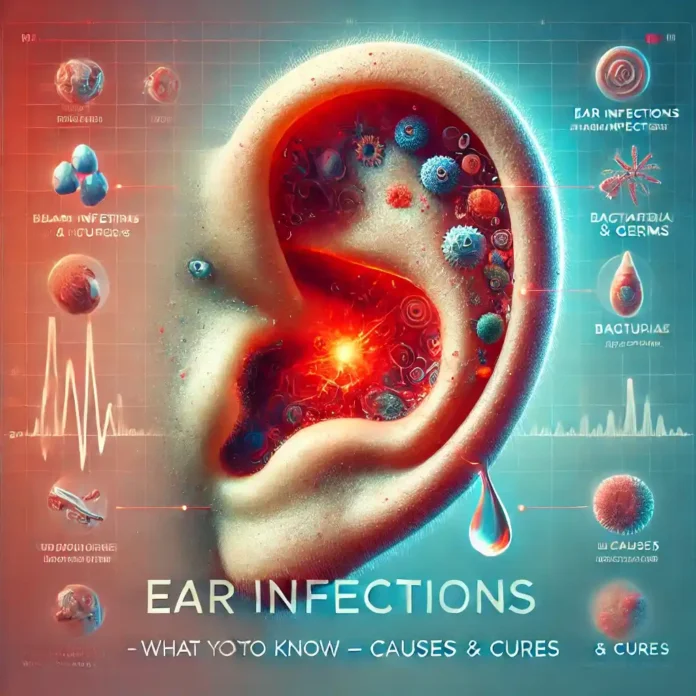Let’s talk about ear infections. Whether you’re a parent dealing with a crying toddler or an adult feeling like your ear is hosting a rock concert, ear infections are no fun. But what exactly are they, why do they happen, and how can you get rid of them?
In this blog, we’ll dive into everything you need to know about ear infections – from the science behind them to practical tips for prevention and treatment. So, grab a cozy seat (and maybe a warm compress), and let’s get started!
What Is an Ear Infection?
An ear infection, also known as otitis media, occurs when the middle ear (the space behind the eardrum) becomes inflamed and filled with fluid. This can lead to pain, pressure, and sometimes even hearing loss. Ear infections are most common in kids, but adults can get them too.
Types of Ear Infections
Not all ear infections are created equal. Here are the main types:
- Acute Otitis Media (AOM): The most common type, often caused by bacteria or viruses. It comes on suddenly and can be quite painful.
- Otitis Media with Effusion (OME): This happens when fluid builds up in the middle ear without infection. It’s common after a cold or AOM.
- Chronic Otitis Media: Recurring infections or fluid buildup that lasts for weeks or months.
What Causes Ear Infections?
Ear infections often start with a cold, flu, or allergy that causes swelling and congestion in the nasal passages and throat. This can block the Eustachian tube (the tiny passage that connects the middle ear to the back of the throat), leading to fluid buildup and infection.
Other risk factors include:
- Age: Kids under 3 are more prone to ear infections because their Eustachian tubes are shorter and more horizontal.
- Season: Ear infections are more common in fall and winter when colds and flu are rampant.
- Exposure to Smoke: Secondhand smoke can irritate the Eustachian tube and increase infection risk.
- Bottle Feeding: Babies who drink from a bottle while lying down are more likely to get ear infections than breastfed babies.
Symptoms to Watch For
Ear infections can be sneaky, but here are some common signs:
- Ear Pain: The hallmark symptom, especially when lying down.
- Fluid Drainage: Pus or fluid leaking from the ear.
- Hearing Loss: Muffled sounds or difficulty hearing.
- Fever: Especially in kids.
- Irritability: Fussiness or crying in babies and toddlers.
- Balance Issues: Dizziness or trouble staying upright.
How Are Ear Infections Treated?
The good news? Most ear infections clear up on their own. But here’s what you can do to ease the pain and speed up recovery:
- Pain Relief: Over-the-counter pain relievers like ibuprofen or acetaminophen can help with pain and fever.
- Warm Compress: A warm cloth held against the ear can soothe discomfort.
- Antibiotics: If the infection is bacterial and severe, your doctor may prescribe antibiotics.
- Ear Drops: Medicated drops can help with pain and inflammation.
For chronic or severe cases, your doctor might recommend:
- Ear Tubes: Tiny tubes inserted into the eardrum to help drain fluid and prevent infections.
- Surgery: Rarely, surgery is needed to remove infected tissue or repair the eardrum.
How to Prevent Ear Infections
Prevention is always better than cure. Here’s how to reduce your risk:
- Practice Good Hygiene: Wash hands frequently to avoid colds and flu.
- Stay Up-to-Date on Vaccines: The flu vaccine and pneumococcal vaccine can help prevent infections.
- Avoid Smoke: Keep your home smoke-free.
- Breastfeed if Possible: Breastfeeding for at least 6 months can boost your baby’s immunity.
- Dry Ears Thoroughly: After swimming or bathing, make sure ears are dry to prevent swimmer’s ear.
When to See a Doctor
While most ear infections resolve on their own, you should seek medical attention if:
- Symptoms last more than 2-3 days.
- There’s severe pain or high fever.
- Fluid, pus, or blood drains from the ear.
- Hearing loss or balance issues occur.
Final Thoughts
Ear infections might be common, but they don’t have to ruin your day (or your week). By understanding the causes, recognizing the symptoms, and knowing how to treat and prevent them, you can tackle ear infections head-on.
So, the next time your ear starts throbbing, don’t panic – you’ve got the knowledge to handle it like a pro. Stay informed, stay healthy, and keep those ears happy!
Read more health and self-care blogs
Disclaimer
Sengideons.com does not host any files on its servers. All point to content hosted on third-party websites. Sengideons.com does not accept responsibility for content hosted on third-party websites and does not have any involvement in the same.













